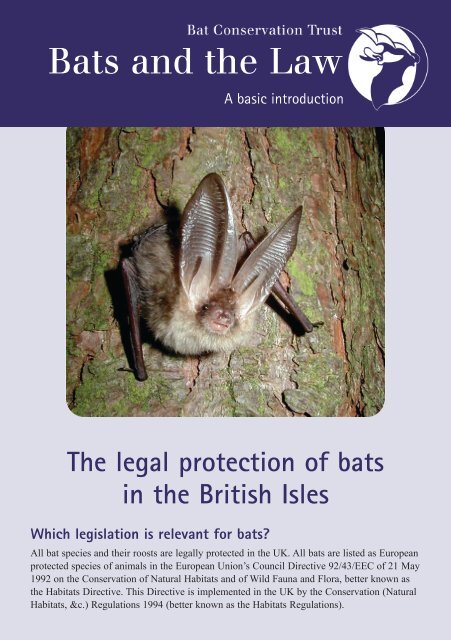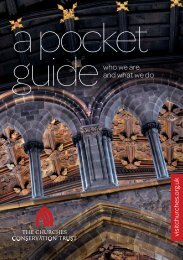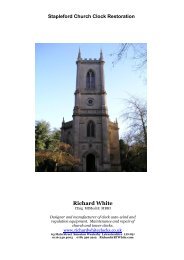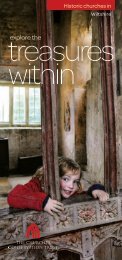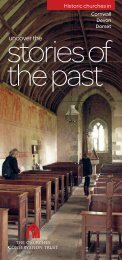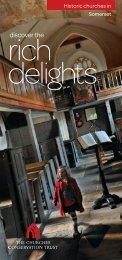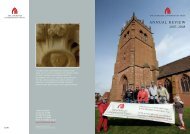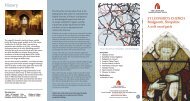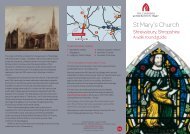Bats and the Law - The Churches Conservation Trust
Bats and the Law - The Churches Conservation Trust
Bats and the Law - The Churches Conservation Trust
- No tags were found...
Create successful ePaper yourself
Turn your PDF publications into a flip-book with our unique Google optimized e-Paper software.
<strong>Bats</strong> <strong>and</strong> <strong>the</strong> <strong>Law</strong>A basic introduction<strong>The</strong> legal protection of batsin <strong>the</strong> British IslesWhich legislation is relevant for bats?All bat species <strong>and</strong> <strong>the</strong>ir roosts are legally protected in <strong>the</strong> UK. All bats are listed as Europeanprotected species of animals in <strong>the</strong> European Union’s Council Directive 92/43/EEC of 21 May1992 on <strong>the</strong> <strong>Conservation</strong> of Natural Habitats <strong>and</strong> of Wild Fauna <strong>and</strong> Flora, better known as<strong>the</strong> Habitats Directive. This Directive is implemented in <strong>the</strong> UK by <strong>the</strong> <strong>Conservation</strong> (NaturalHabitats, &c.) Regulations 1994 (better known as <strong>the</strong> Habitats Regulations).
Amendments to <strong>the</strong> Habitats Regulations in each country by:• <strong>The</strong> <strong>Conservation</strong> (Natural Habitats, &c.) (Amendment) Regulations 2007 – in Engl<strong>and</strong><strong>and</strong> Wales• <strong>The</strong> <strong>Conservation</strong> (Natural Habitats, &c.) Amendment (Scotl<strong>and</strong>) Regulations 2007• <strong>The</strong> <strong>Conservation</strong> (Natural Habitats, &c.) (Amendment) Regulations (Nor<strong>the</strong>rn Irel<strong>and</strong>)2007mean that, for practical purposes, <strong>the</strong> protection of bats <strong>and</strong> <strong>the</strong>ir roosts now falls mostlyunder <strong>the</strong> Habitats Regulations in all four countries. Fur<strong>the</strong>r amendments were made in eachcountry in 2008/09. <strong>The</strong>re is also some protection for bats <strong>and</strong> roosts in Engl<strong>and</strong> <strong>and</strong> Walesunder <strong>the</strong> Wildlife & Countryside Act 1981 (as amended by <strong>the</strong> Countryside <strong>and</strong> Rights ofWay Act 2000).Isle of Man <strong>and</strong> <strong>the</strong> Channel Isl<strong>and</strong>s have <strong>the</strong>ir own legal systems. <strong>Bats</strong> <strong>and</strong> roosts areprotected under <strong>the</strong> Wildlife Act 1990 (as amended) in <strong>the</strong> Isle of Man, <strong>and</strong> by <strong>the</strong><strong>Conservation</strong> of Wildlife (Jersey) <strong>Law</strong> 2000 in Jersey, legislation covering <strong>the</strong> Bailiwick ofGuernsey is under development.How does <strong>the</strong> law protect bats?<strong>The</strong> wording of <strong>the</strong> legislation varies slightly across <strong>the</strong> British Isles <strong>and</strong> is difficult tosummarise succinctly, so you should refer to your country’s relevant legislation for <strong>the</strong> precisewording. This leaflet cannot cover all <strong>the</strong> offences against bats/roosts, but in summary, it is anoffence in <strong>the</strong> UK to:❍❍❍❍deliberately (or recklessly in Scotl<strong>and</strong>) capture, injure or kill a batdeliberately (or recklessly in Scotl<strong>and</strong>) disturb a bat in a way that would(significantly in Scotl<strong>and</strong>) affect its ability to survive, breed or rear young (orhibernate or migrate in Engl<strong>and</strong>, Wales <strong>and</strong> Nor<strong>the</strong>rn Irel<strong>and</strong>) or (significantly inEngl<strong>and</strong>, Wales <strong>and</strong> Scotl<strong>and</strong>) affect <strong>the</strong> local distribution or abundance of <strong>the</strong> species.damage or destroy a roost (this is an ‘absolute’ offence)possess, control, transport, sell, exchange or offer for sale/exchange any live or deadbat or any part of a batIn addition to <strong>the</strong> above:In Scotl<strong>and</strong> it is an offence to:❍❍❍deliberately or recklessly harass a bat,or disturb a bat at a roostdeliberately or recklessly disturb amigrating or hibernating batdeliberately or recklessly obstructaccess to a roostDaubenton’s bat© Hugh Clark
<strong>The</strong> potential fine for each offence is £5,000 <strong>and</strong>, if more than one bat is involved, £5,000 perbat. An offender can also be imprisoned for six months. <strong>The</strong> forfeiture of any bat or o<strong>the</strong>rthing by <strong>the</strong> court is m<strong>and</strong>atory on conviction, <strong>and</strong> items used to commit <strong>the</strong> offence –vehicles, for example – may be forfeited.Public bodies including local authorities<strong>The</strong> Natural Environment <strong>and</strong> Rural Communities Act 2006 <strong>and</strong> Nature <strong>Conservation</strong>(Scotl<strong>and</strong>) Act 2004 place a duty on public bodies to have regard to <strong>the</strong> requirements ofbiodiversity in carrying out <strong>the</strong>ir functions. In addition, local authority planning departmentsshould also meet <strong>the</strong> requirements of Planning Policy Statement 9 (Engl<strong>and</strong>), TechnicalAdvice Note 5 (Wales), National Planning Policy Guidance 14 (Scotl<strong>and</strong>) <strong>and</strong> Planning PolicyStatement 2 (Nor<strong>the</strong>rn Irel<strong>and</strong>).This leaflet is not intended to answer specialist Common pipistrelle batqueries or problems <strong>and</strong> so you should refer to<strong>the</strong> relevant legislation for your country fordetailed information. Fur<strong>the</strong>r information onwhat to do when <strong>the</strong> law is broken, along withinformation on bats <strong>and</strong> <strong>the</strong>ir roosts, isavailable from <strong>the</strong> Bat <strong>Conservation</strong> <strong>Trust</strong>.ContactsBat <strong>Conservation</strong> <strong>Trust</strong>15 Cloisters House, 8 Battersea Park Road,London SW8 4BGBat Helpline 0845 1300 228 www.bats.org.ukemail investigations@bats.org.uk© Hugh ClarkStatutory Nature <strong>Conservation</strong> Organisations (SNCOs):Natural Engl<strong>and</strong>Telephone 0845 600 3078www.naturalengl<strong>and</strong>.org.ukCountryside Council for WalesTelephone 0845 1306 229www.ccw.gov.ukScottish Natural HeritageTelephone 01463 725000www.snh.org.ukNor<strong>the</strong>rn Irel<strong>and</strong> Environment AgencyTelephone 0845 302 0008www.ni-environment.gov.uk<strong>The</strong> information provided here is believed to be correct. However, no responsibility can be acceptedby <strong>the</strong> Bat <strong>Conservation</strong> <strong>Trust</strong> or any of its partners or officers for any consequences of errors oromissions, nor responsibility for loss occasioned to any person acting or refraining from action asa result of this information <strong>and</strong> no claims for compensation or damage will be accepted.Updated March 2010Cover image: Brown long-eared close-up on tree. © John Altringham<strong>The</strong> Bat <strong>Conservation</strong> <strong>Trust</strong> (known as BCT) is a registered charity inEngl<strong>and</strong> <strong>and</strong> Wales (1012361) <strong>and</strong> in Scotl<strong>and</strong> (SC040116).Company limited by guarantee, registered in Engl<strong>and</strong> no: 2712823VAT reg. no. 877158773.Produced wth <strong>the</strong> support of


